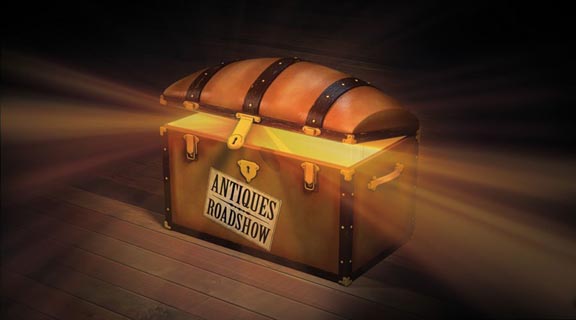

What It's Like to Attend PBS's Antiques Roadshow

It all started when my wife inherited this ivory inlaid table:
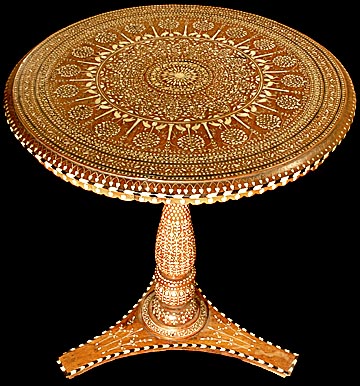
With over 9,000 pieces of inlaid ivory we thought it might have a chance to be featured on PBS's famous Antique Roadshow. We applied for tickets and asked all our friends and relatives to do the same for five years in a row before we finally got lucky in 2013. This page chronicles the good, the bad and the ugly of attending the Antiques Roadshow.
The first step to get tickets is to apply for them via the Antiques Roadshow website. The process is fast and easy. Two months before the event for which tickets were requested you should receive and email telling you if you did or didn't get them. I say "should" because some of the years we never heard that we didn't get them and in 2013 our daughter, who applied for us, didn't receive an email stated that she "had" received them even though she ended up getting some. If you are one of the lucky ones to get tickets, they arrive approximately two weeks before the event. They are sent in very unassuming, plain envelopes that are easy to miss judge as being trash mail, so be sure to open all envelopes you receive as the event date gets close. Here's what the tickets look like:
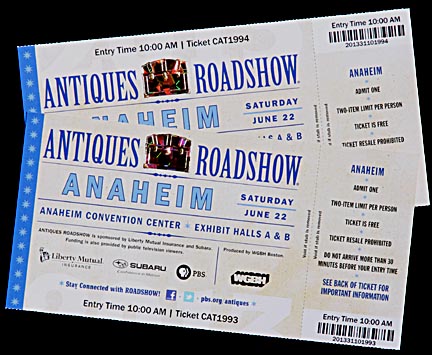
The small treasure chests are actually faceted gold. In this image they look multicolored because they refracted the light from the flash. Getting Antiques Roadshow tickets is an exercise in patience. It's not unusual for over 100,000 ticket requests to be made for a single event. From all of those only 2,500 to 3,000 will be lucky enough to get a pair of tickets. Some people get lucky their first try. Most will have to apply many times to receive them. We ended up getting two sets of tickets out of 30 applications, so based on this admittedly small sample space the argument could be made that the odds of getting tickets are 1 in 15.
Each ticket admits one person, who can bring two items for appraisal. All the terms and conditions of attending are printed on the back in microscopically small lettering. Our tickets were for the Antiques Roadshow on 22 June, 2013, at the Anaheim Convention Center in Anaheim, southern California, right across the street from Disneyland.
While every Antiques Roadshow varies because of differences in where they are held, the following will give you some idea of what to expect:
While the 5,000 to 6,000 people attending an Antiques Roadshow are divided in to nine arrival times (one per hour as indicated on the tickets) there is a constant crowd of daunting proportions. In our case, we arrived at the convention center at 9:15 AM for a 10:00 AM entry time. Although the convention center has four parking lot entry lanes, there was only a single lane on the city street to enter these lanes. That meant we had to struggle through 25 minutes of stop and go traffic to cover two city blocks before entering the parking entrance. Parking was $12.00. Once through that ordeal it took 10 minutes to find a parking spot and another 15 to walk from it to the entry to halls A and B, where the Antiques Roadshow was being staged. The following overhead sketch gives an idea of how it was laid out:

We entered the building at the lower right, where two volunteers (cyan dots) checked to make sure we had tickets. We were then directed through a passageway into an immense open building large enough to house two football fields. A second volunteer gave us two program guides...
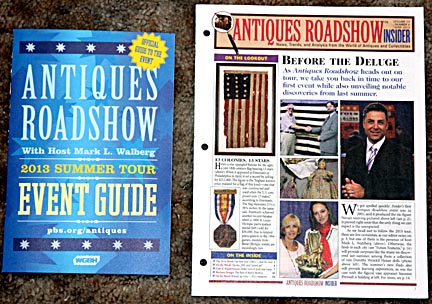
...and directed us to go to the end of the magenta line, which had 800 people slowly shuffling along. Anyone arriving at the Antiques Roadshow more than 30 minutes before the time on their tickets were asked to wait in a holding line (blue) until their time was due.
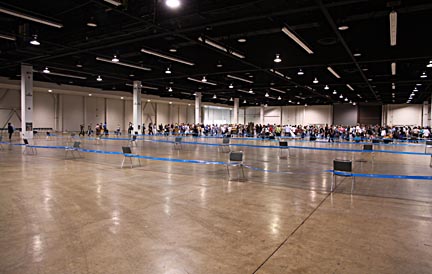
Our first view of the first, but by far not the last, line we had to endure.
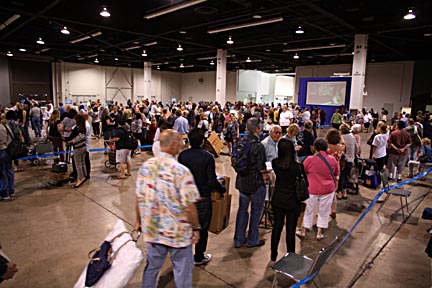
The view from the end of the line. A huge TV was set up showing highlights of past high-end appraisals.
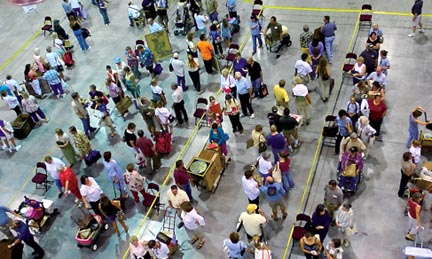
An overhead view of a small part of the line to enter the Antiques Roadshow.
A curious feature of this line is that it doesn't move smoothly. Rather you move forward in pulses. There's typically a three to five minute pause then all of a sudden you move forward 20 or more feet. This is caused by a small group in line getting caught up in conversation and not noticing that the people in front of them had moved forward. Another source is from people watching the large TV while the line moves away from them.
Most interesting of all is the general atmosphere of the Antiques Roadshow. It's one of quiet, calm, pleasant anticipation. The "quiet" surprised me because there were many hundreds of people there. Looking around at the participants disclosed why: everyone was old. I estimate the average age at 60. We only saw two teenagers and one child in the entire line. Older people tend to be more reserved and polite, hence the quiet. It took my wife and I 40 minutes to approach the front of the line. During this time there were many volunteers walking up and down the lines to make sure everyone was okay. While waiting in line is not my favorite activity, waiting in an Antiques Roadshow line is as pleasant as the experience can be. Everyone is happy and relaxed and easy conversations start up all the time about what antiques were brought. Just standing and looking around is entertaining because every few seconds you catch a glimpse of one unusual treasure or another.
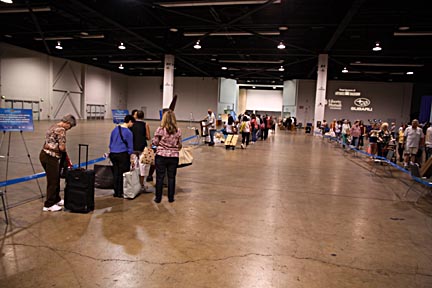
Halfway
through the final leg of the line, a volunteer took our ticket stubs
and left the larger part of the ticket with us. It was at this point
that all antiques had to be unwrapped.
At
the end of this last bit of line were two sorting tables, the red
blocks on the diagram.
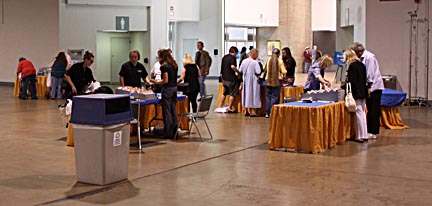
You show the people at them what you have and they give you one ticket for each item. The ticket tells you what appraisal line to get in for that item.
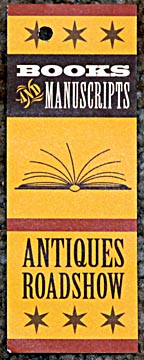
This ticket was for an 1813 Bible.
After getting your item tickets you are directed through another passageway into a second hall as large as the first. In the center of the hall was a circle of 12-foot tall blue canvas panels. Inside this circle were the actual appraisers and the area where special appraisals were filmed. Let's take a second look at the overhead sketch.

Before going through the passage into the appraisal hall there was a sign stating that no photography was permitted in the Antiques Roadshow hall. Two volunteers at the entrance to the passageway made sure no one tried leaving through this entryway once they had entered. Tape on the floor (cyan lines) marked a barrier manned by as many as a dozen volunteers, whose job it was to escort you to the first line for getting your first item appraised. To get to an appraiser you have to wait in a line associated with his or her specialty. There are 30 categories. Each has a waiting line of people, as designated by the thin black lines on the sketch. The average wait in one line is 25 minutes. Some lines, like glass and clocks, had practically no line at all. Silver was a 20 minute wait. Folk art was 40 minutes. The most common items, collectables and paintings, had horrific lines 100 people long that took over two hours to get through.

Pink tape outlined the waiting lines to see appraisers. They were barely shoulder width apart.
There are many chairs in fixed locations close to the lines for people to rest on and several water stands with disposable cups for drinking.
All the lines converge on a few narrow openings, each of which is controlled by more volunteers who pass people in one at a time as appraisers are available, cancelling each item ticket as they do so. While I acknowledge the necessity of crowd control, these narrow entrances to the appraisal area are painful choke points because so many people are in line to get in while at the same time people have to exit the appraisal area through the same narrow openings. Making things worse is people going in and out of the openings with dollies and carts that are too wide for the limited space. Not all venues are the same so some Antiques Roadshows may have more convenient, wider openings.
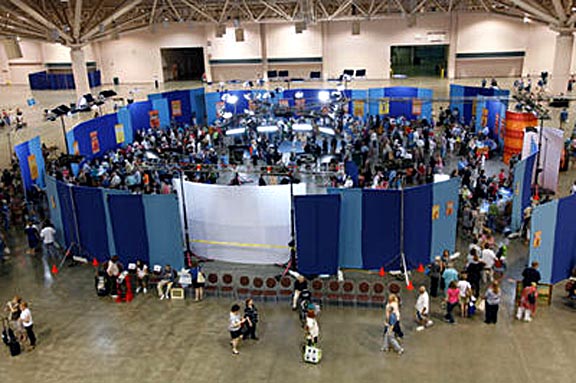
An aerial view of the actual Antiques Roadshow appraisal area during one of the few moments when the lines were short.
Once inside the appraisal area, still another volunteer leads you to the appraiser for your item. The line to talk to him or her was usually only one or two people deep and only lasted five to ten minutes, depending on how complicated the appraisals ahead of you are. Filming of special appraisals takes place in the center of the appraisal zone (green carpeted area.) The problem is that you aren't supposed to walk on the carpeting, yet so many people are crammed into the small appraisal area that you can't avoid walking on it. Filming is always taking place. I'd estimate 120 items are filmed during the average Antiques Roadshow, of which only 16 will make it into a one-hour show.
What was a pleasure to discover was that once you finally got to an appraiser they were very happy to take their time and explain as much about the item you brought as you wanted to hear. They genuinely seemed interested in everyone's treasure, even if it wasn't worth anything.
Another surprise was that the appraisers we see on the actual Antiques Roadshow are the ones behind the tables (orange lines) making appraisals. I expected that all the appraisers would be worker-bee types and the celebrity appraisers would only come out when an item was special enough to warrant being filmed. This was not the case. I actually rubbed elbows with one of the Keno brothers! (I wish my table had been worth as much as his hand tailored suit. I never saw anything that fit anyone so well before in my life. It was like a work of art in its own right.)
Once your item has been appraised, you have to somehow make your way out of the appraisal area, find the line for your next item and start waiting all over again. If you get hungry, there's a small concession area (green bar) where you can spend $3.50 for a small drink, $5.00 for a hot dog or $8.00 for a ham sandwich. Prices are high but that's to be expected in a venue such as this. Eating and drinking is permitted in line and most people bring lunch... and the smart ones dinner as well.
Once all of your items have been appraised you are expected to leave the hall by a different passage than you entered, the upper right corner in the overhead sketch. Getting turned around like this makes getting back to your car confusing, particularly since you've just spent many hours waiting in line and your head is aching and your feet are sore. Wandering about is discouraged. I tried it and was instantly greeted by one of the many volunteers walking around and asked if I needed help finding the line I was supposed to be in. It was friendly, but the message was clear.
So, how'd we do? The table that started it all:

...turned out to be quite common. The appraiser said they get three to five every Antiques Roadshow. The inlays were ox bone, not ivory and the table had a retail value of only $300.00. The other items we brought were a 1908 sterling silver mirror worth $200.00:

One week after the Antiques Roadshow we took this mirror to a silversmith to have it restored. The silversmithh mentioned that the $200 appraisal was too low and that in an antique store it would most likely sell for $600. She mentioned that most of the appraisers in Antiques Roadshow aren't really appraisers, but dealers. I have to admit I don't understand the difference.
A 1930s lady's watch worth $1000.00, mainly because it was solid gold:
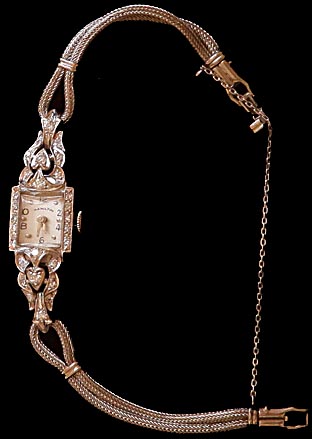
and an 1880s wall clock was worth $225.00:
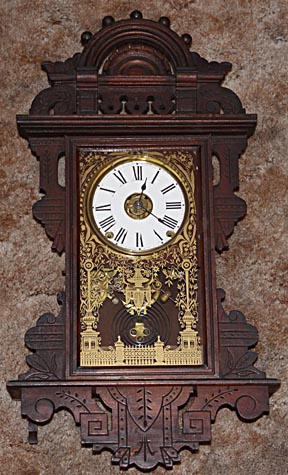
As it happened our daughter and her husband also got tickets. Their items did better. An 1813 family Bibles was appraised for $200.00:
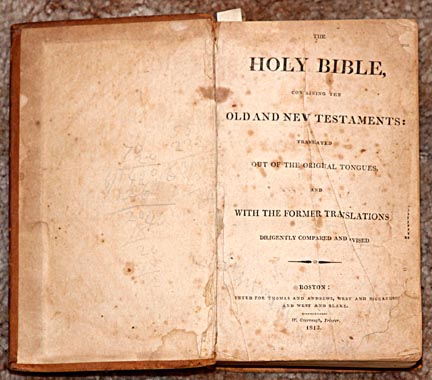
A cradle from the 1820s was worth $500.00:
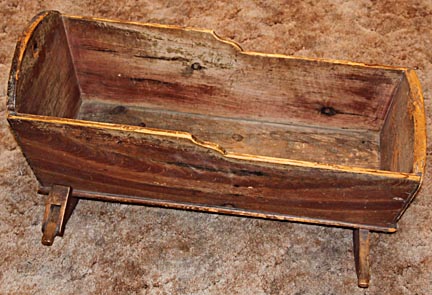
An 1850s brass spyglass was worth $1000.00:

And the big winner for the day was an 1817 flintlock with powder horn worth $5,000.00:

If you plan to attend an Antiques Roadshow I recommend you get tickets for as early in the day as possible. By the end of the day the appraisers get a little blurry-eyed and may not be inclined to spend as much time discussing your treasure. Also, be aware that while the Antiques Roadshow experts are as experienced and knowledgeable as possible, they don't know everything. We noticed that although the man looking at our table said they were common he couldn't provide much information about it; like when it was made, where it was made or how it was made. When asked he Mmmm'd and Err'd until I suggested something from my research then quickly agreed with me.
Going to the Antiques Roadshow was a great experience that I encourage anyone with an interesting item to attend. Yes, waiting in line can be tedious but there are so many interesting conversations to be had that the time goes remarkably fast. We may not have gotten rich... but we had a lot of fun.